Abstract
1. Iontophoretic application of acetylcholine to neurones in the medulla and pons of the unanaesthetized decerebrate cat excited 35·5% and inhibited 22%. This was not a representative sample of lower brain stem neurones, since most penetrations were made medially. Some cholinoceptive neurones were in the medial reticular formation.
2. The time course of the response to different doses has been described.
3. Nicotine and nicotinic agents 1,1-dimethyl-4-phenylpiperazinium iodide (DMPP) and choline phenyl ether (TM1) excited neurones excited by acetylcholine but, with one exception, did not inhibit neurones inhibited by acetylcholine.
4. Muscarinic agents mimicked both the excitatory and inhibitory responses to acetylcholine. (±)-muscarine and bethanechol (β-methylcholine carbamate) had a prolonged and powerful inhibitory action.
5. Oxotremorine [1-(2-oxopyrrolidino)-4-pyrrolidino-butyne-2] had a long-lasting excitatory action on neurones excited by acetylcholine.
6. Eserine and neostigmine potentiated the action of acetylcholine but in addition they had a strong excitatory effect on many brain stem neurones, independently of the action of acetylcholine.
7. Excitatory and inhibitory responses to acetylcholine could be antagonized by gallamine, hexamethonium and atropine. Dihydro-β-erythroidine (DHβE) antagonized only excitatory responses. (+)-Tubocurarine was a weak antagonist.
8. It is concluded that the excitatory responses have both nicotinic and muscarinic properties but the inhibitory responses are only muscarinic. Since the pharmacology of these two types of response is different, it is concluded that the inhibitory action is not due to an indirect effect from excitation of a neighbouring inhibitory neurone.
Full text
PDF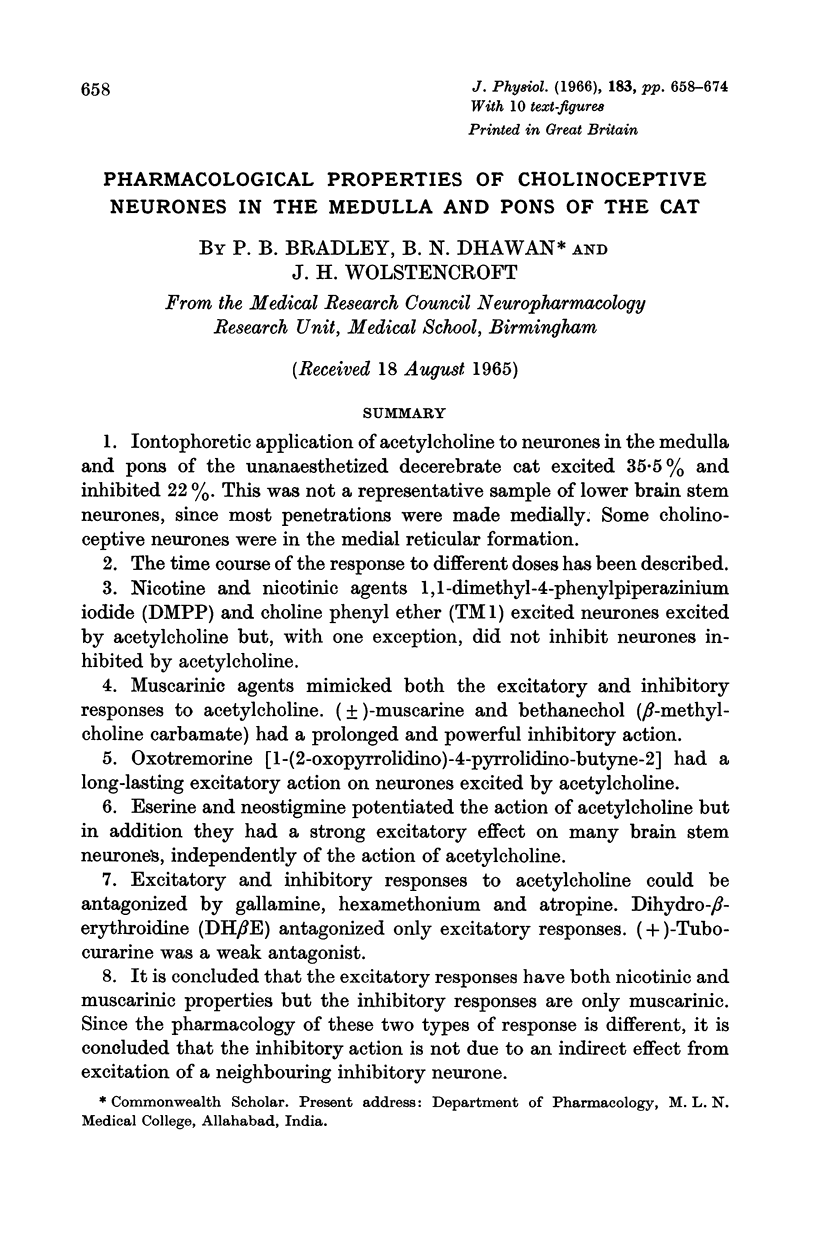
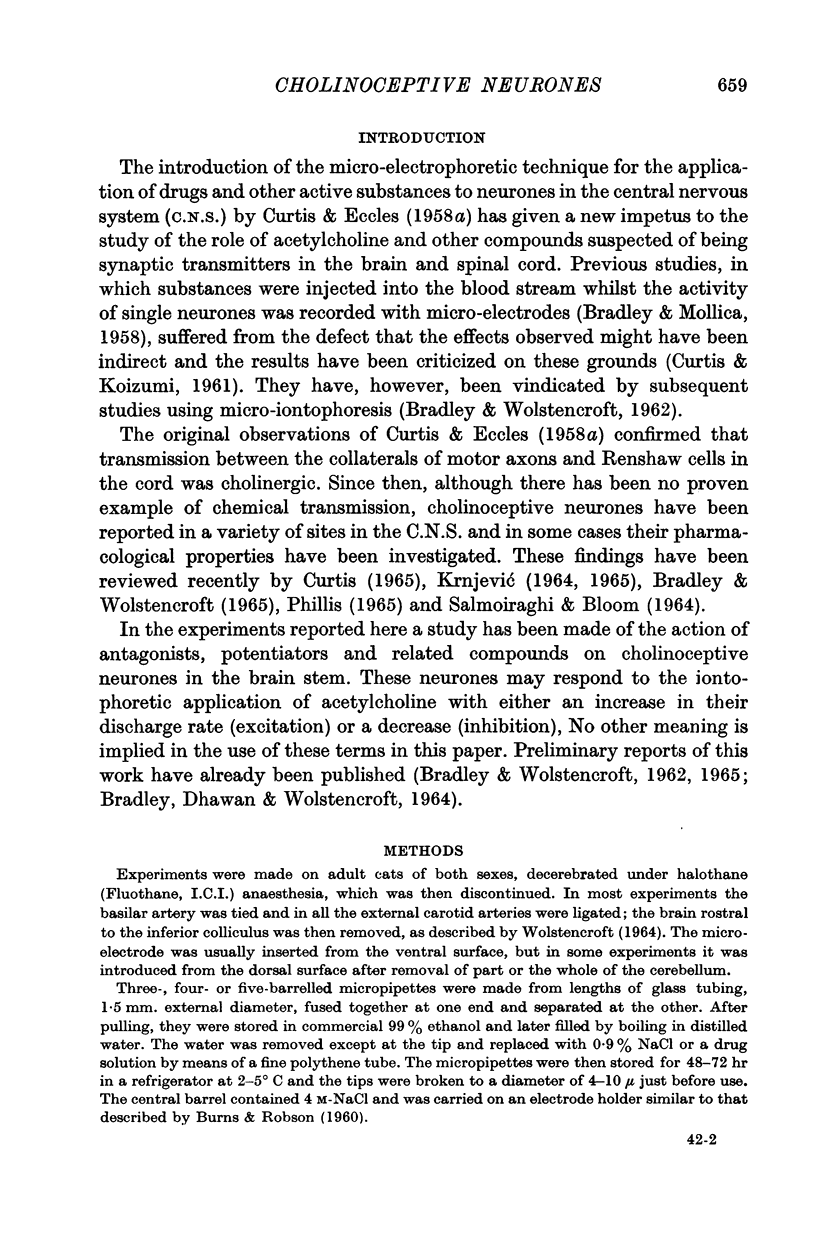
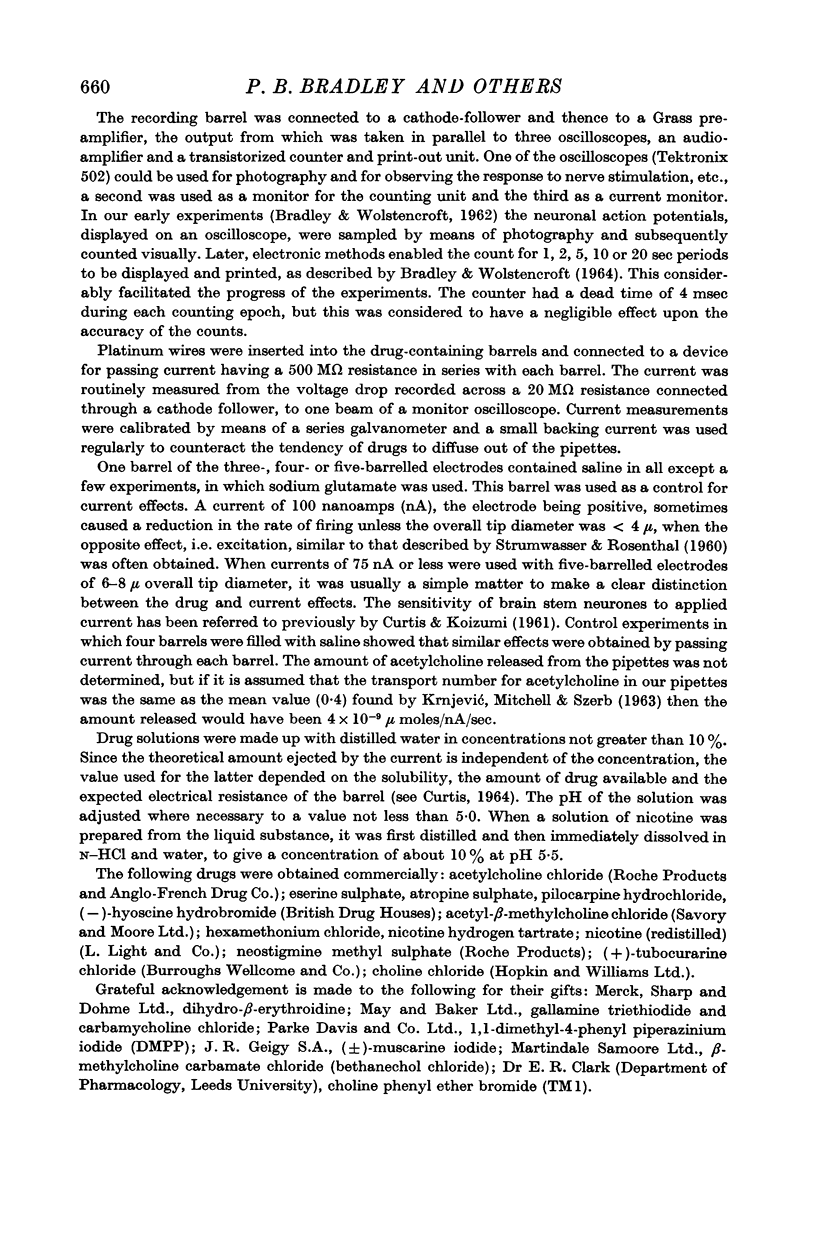
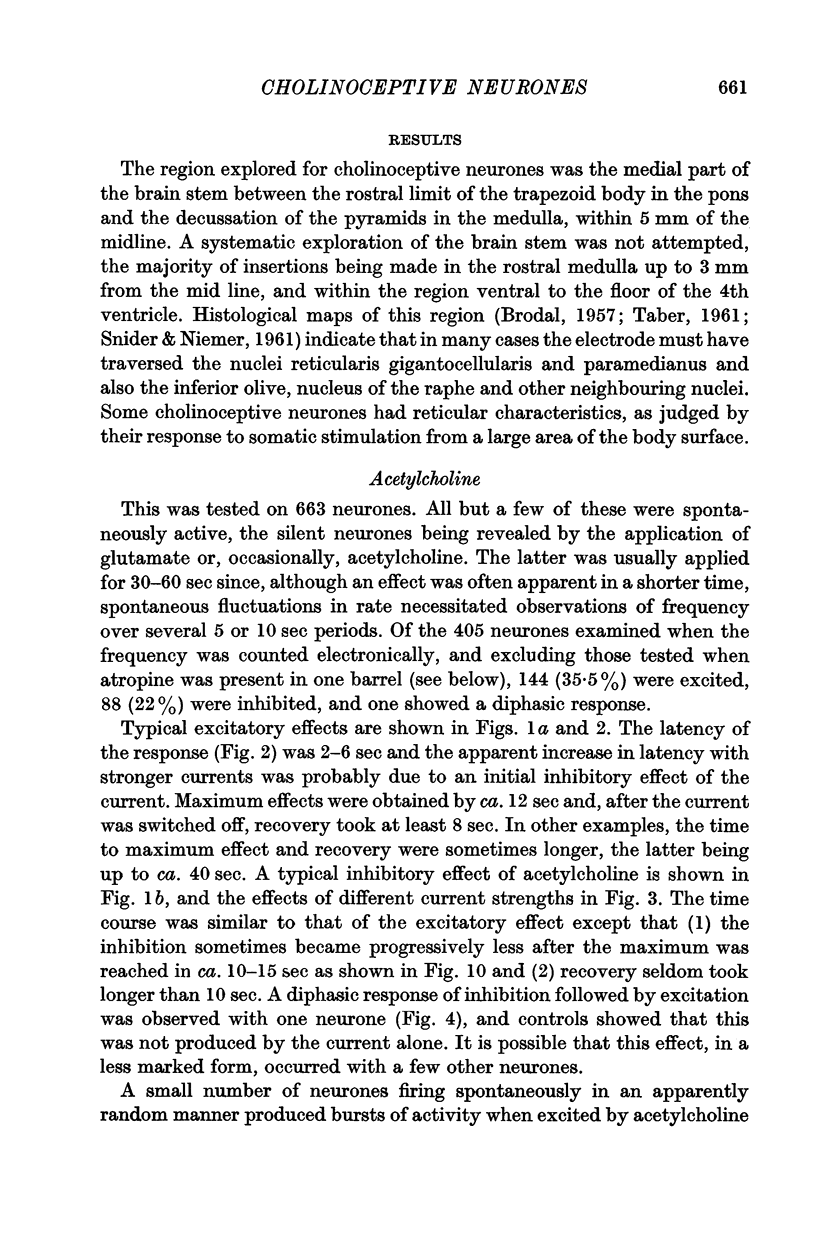
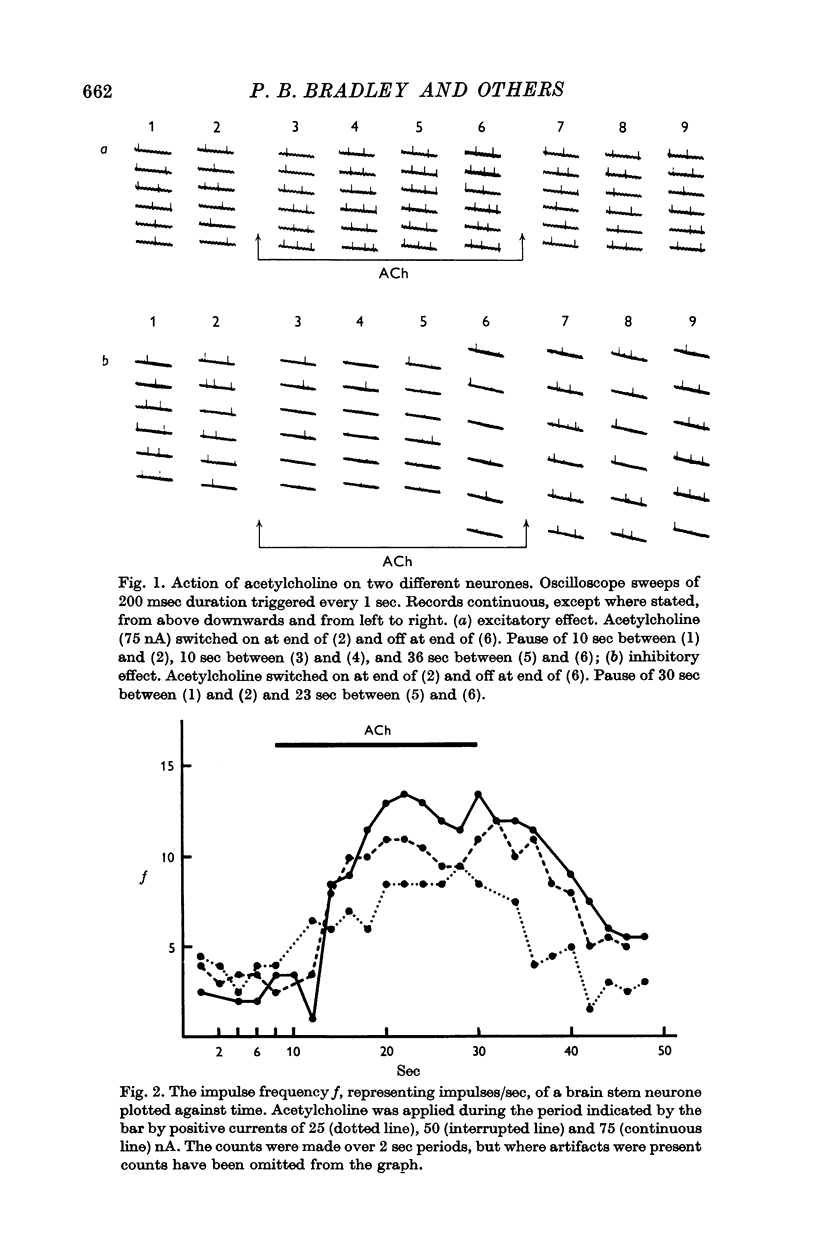
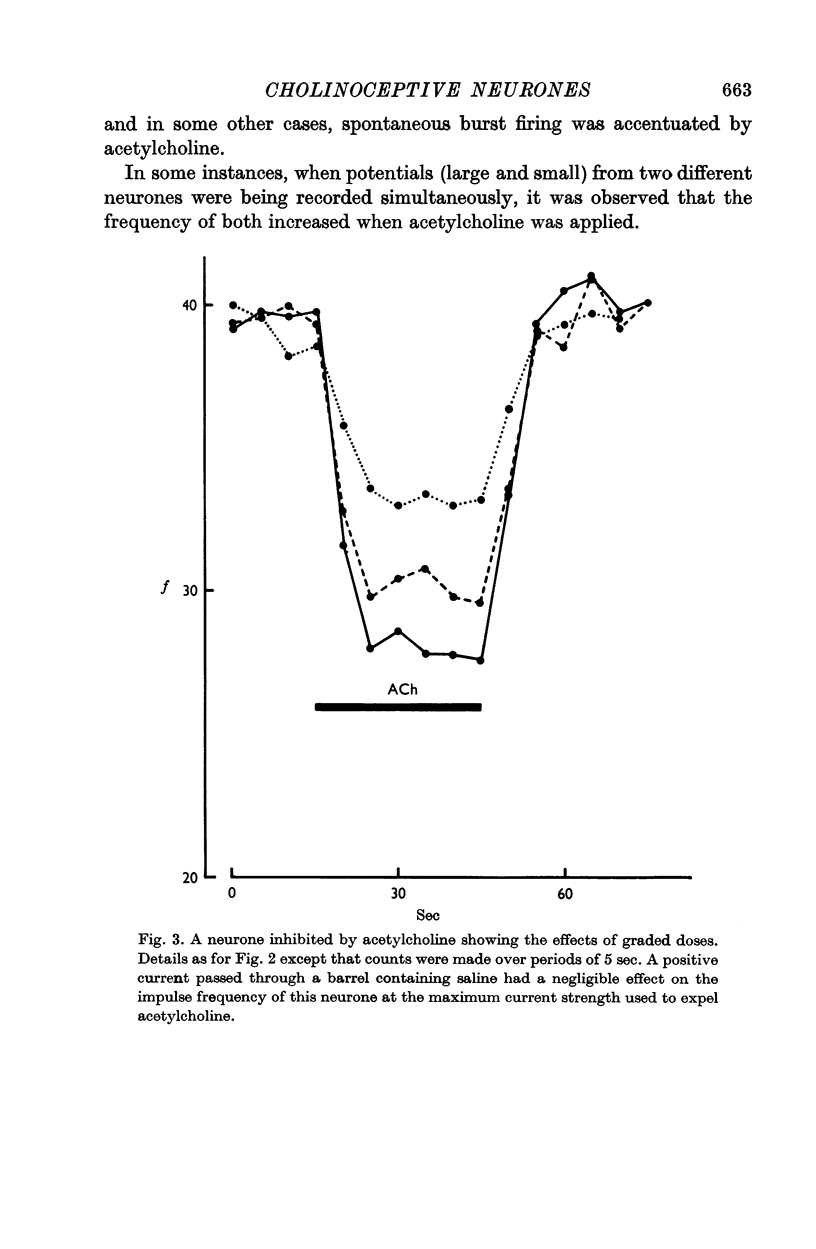
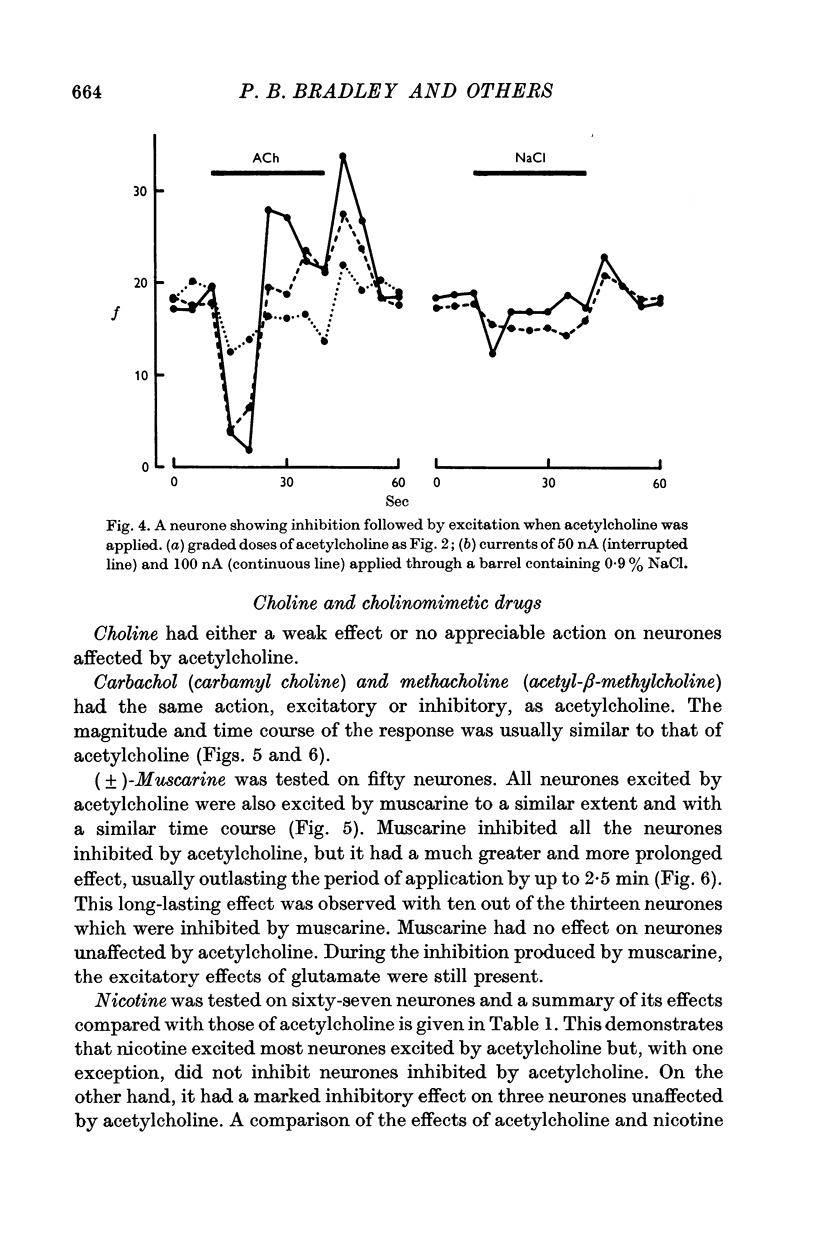
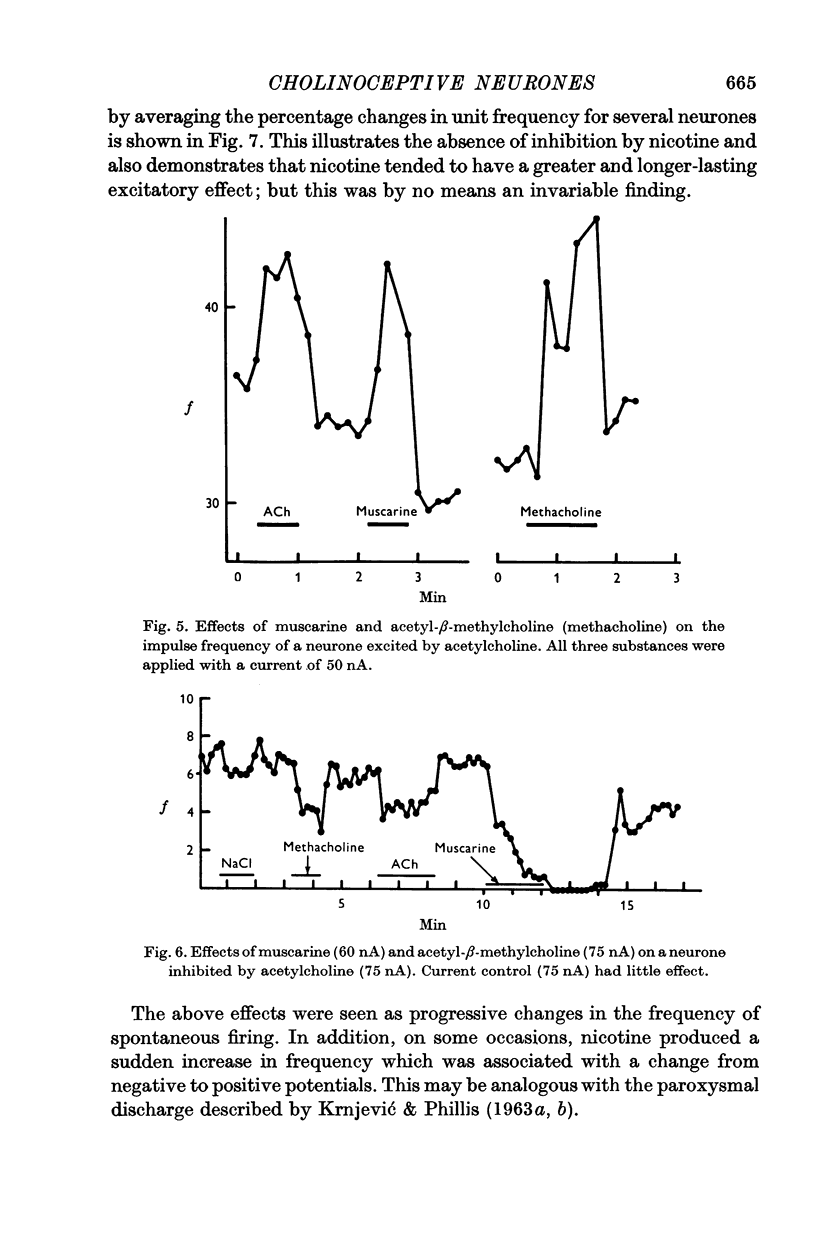
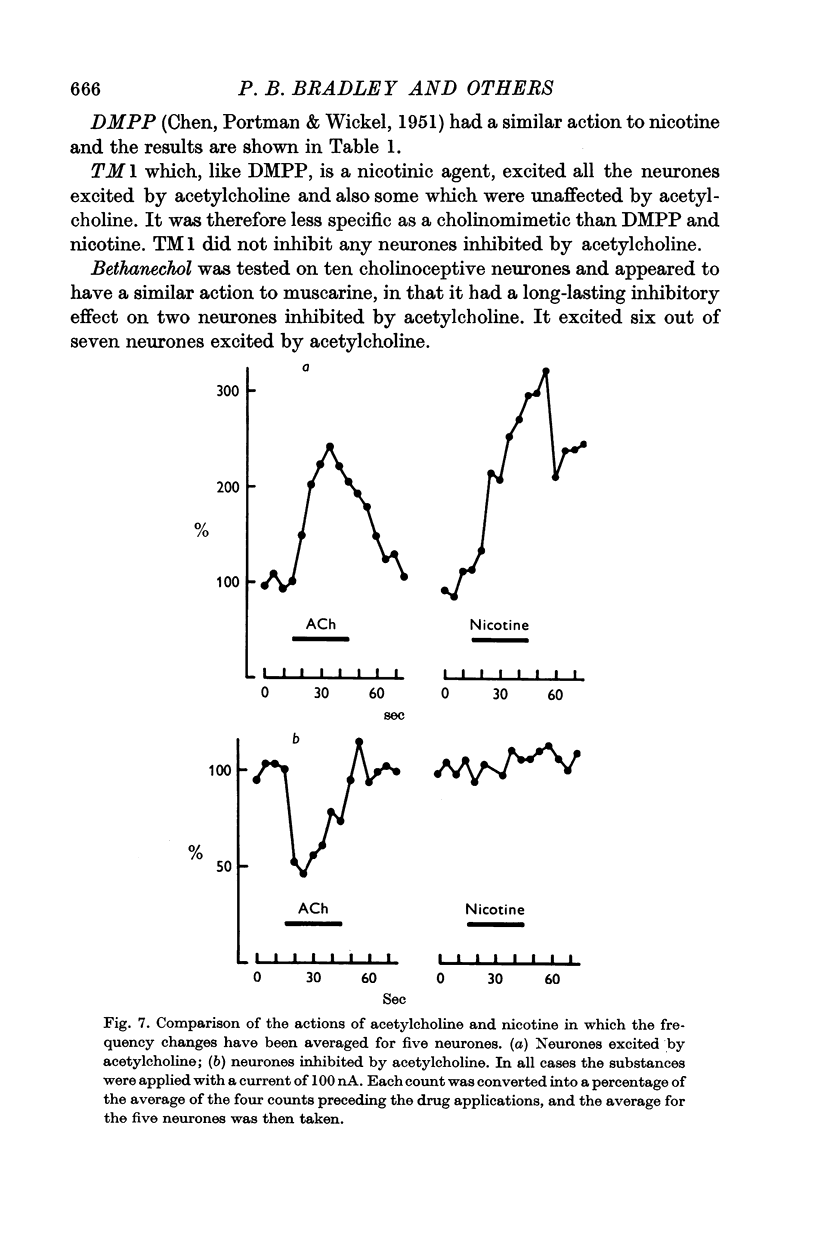
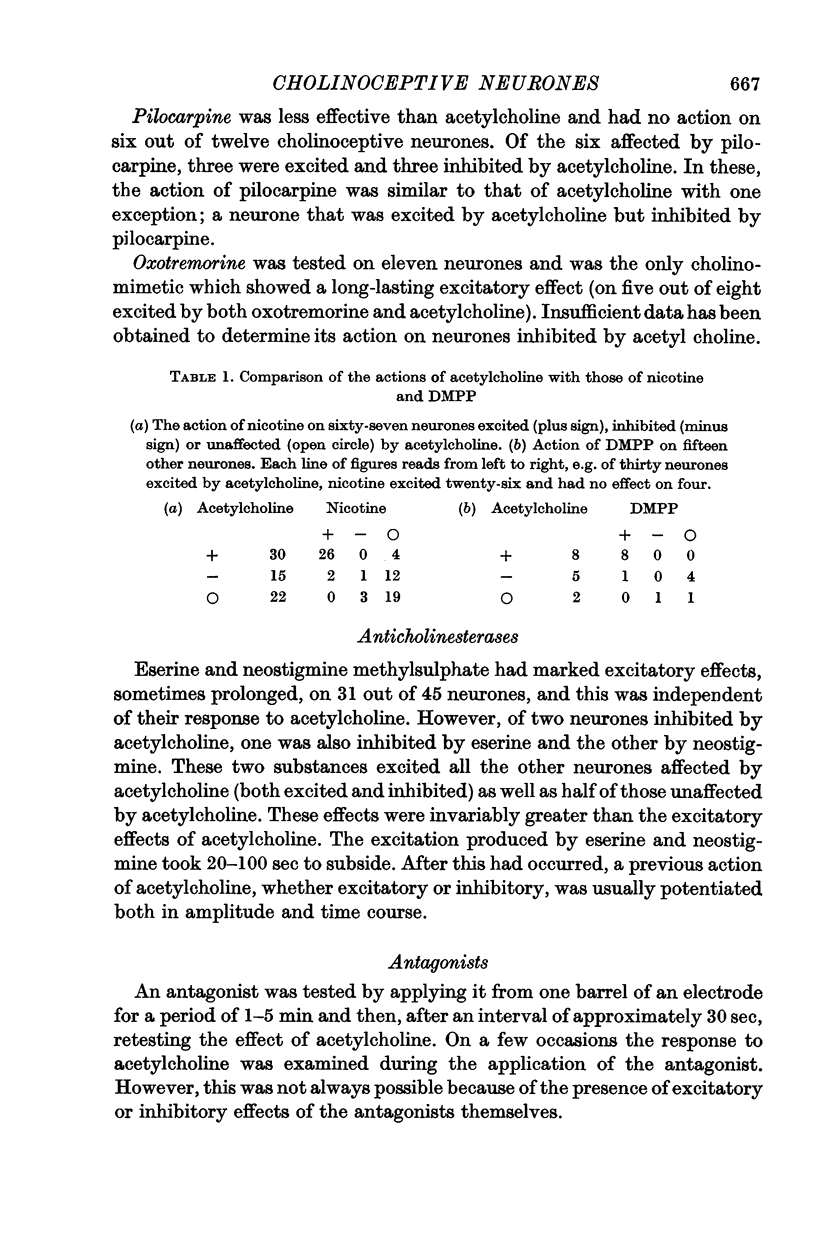
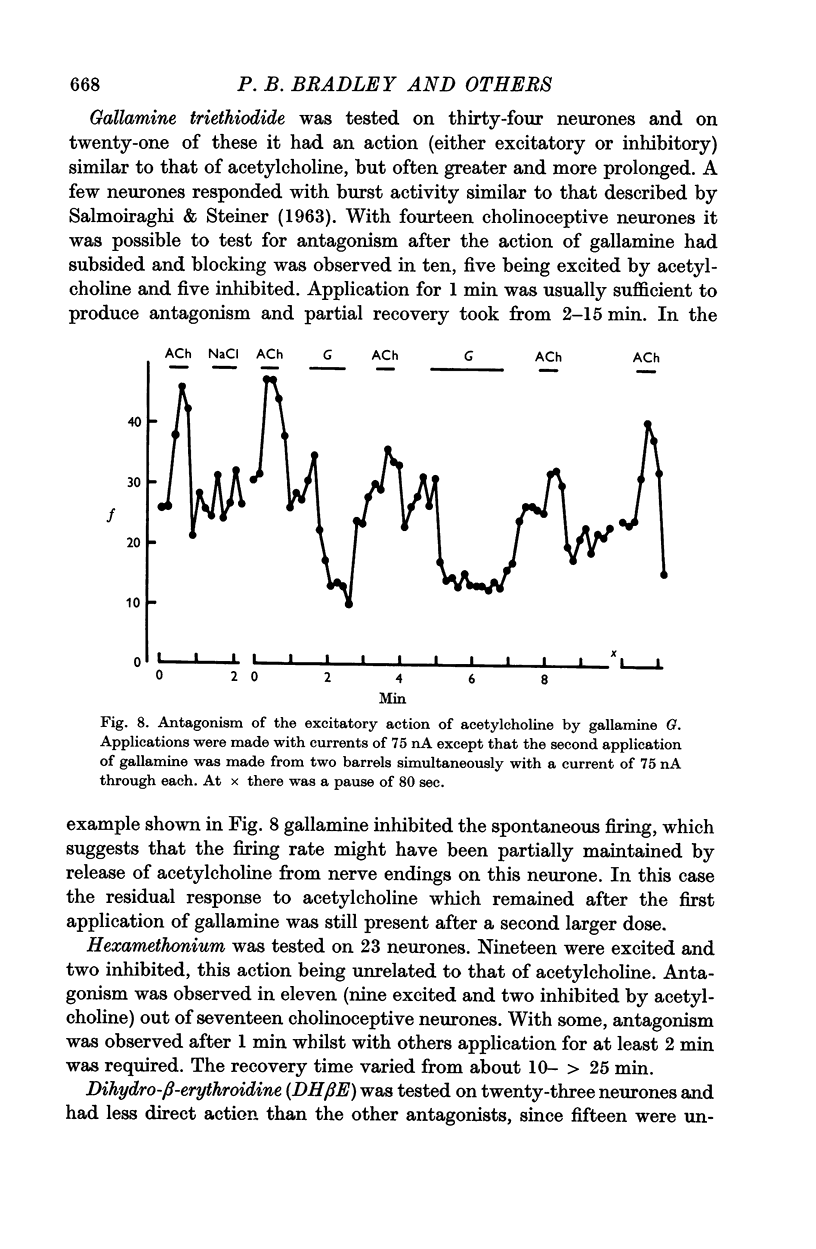
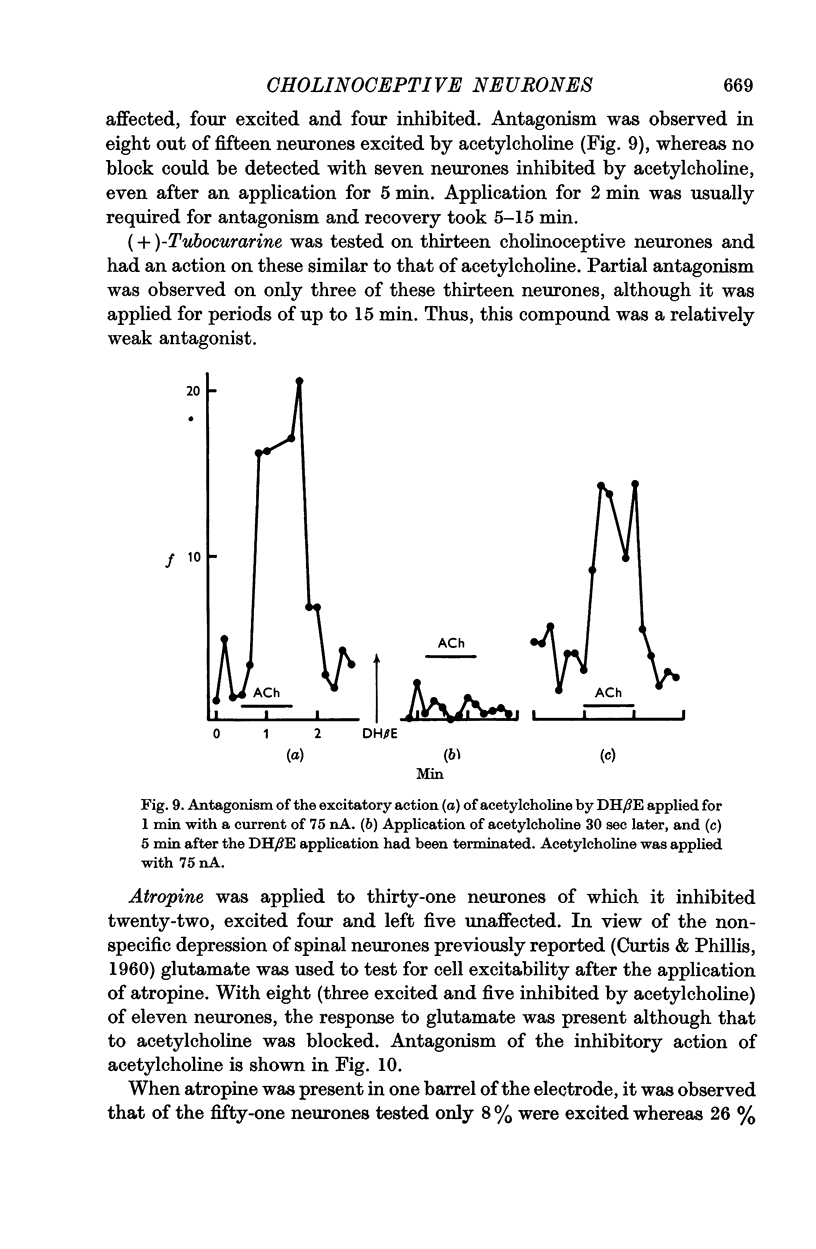
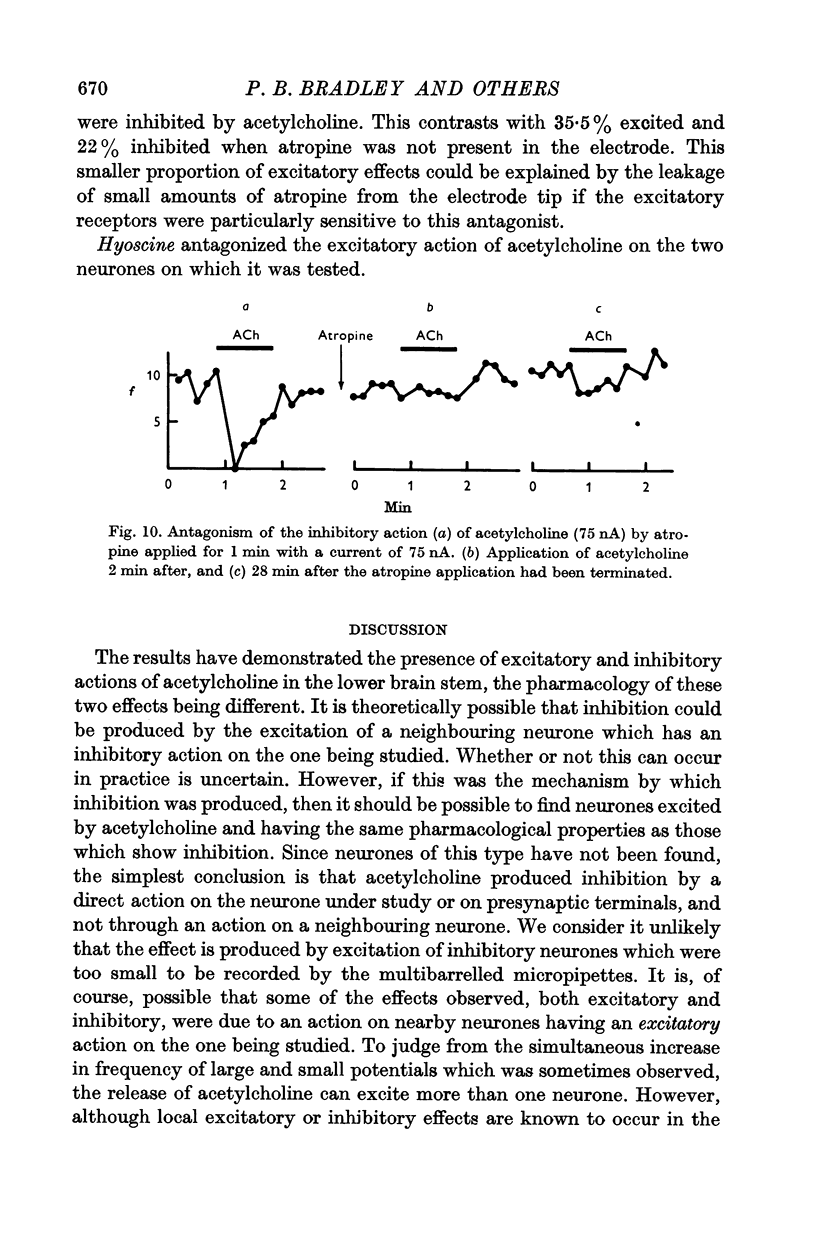
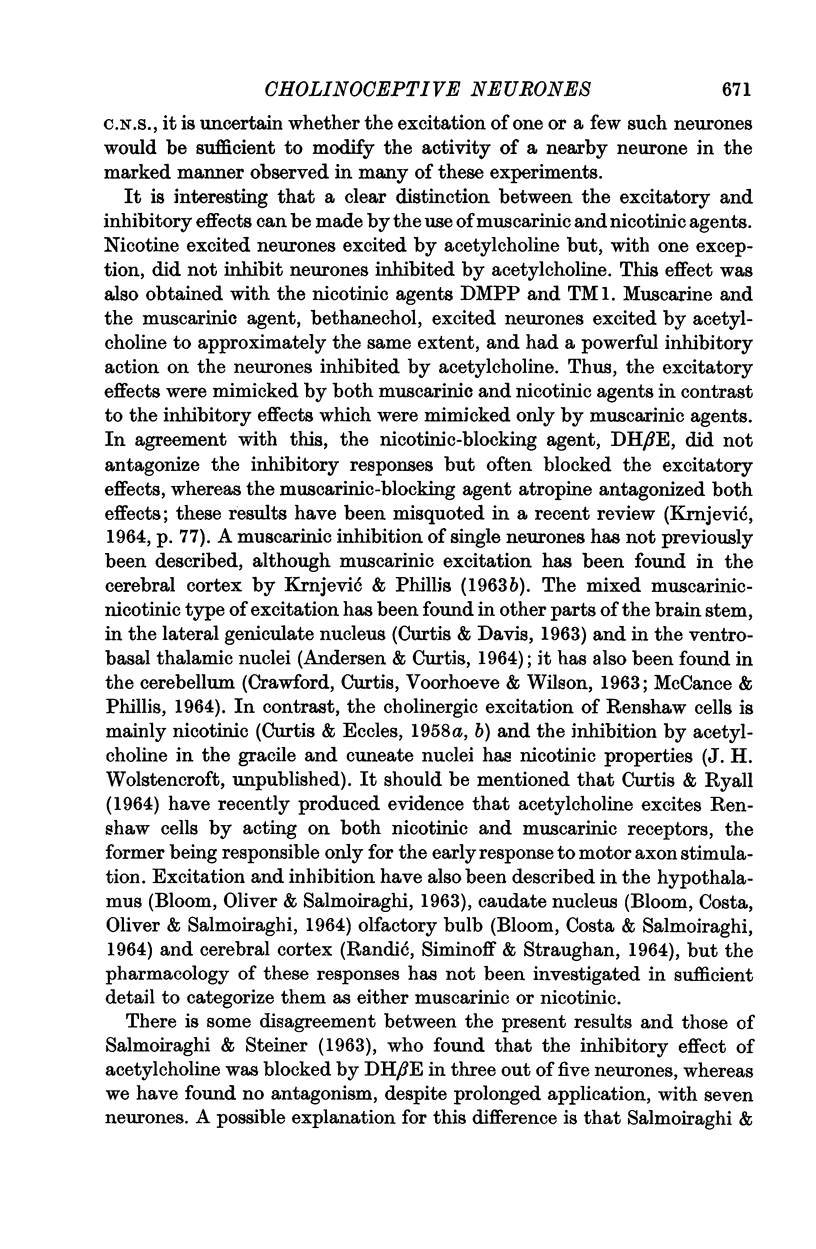
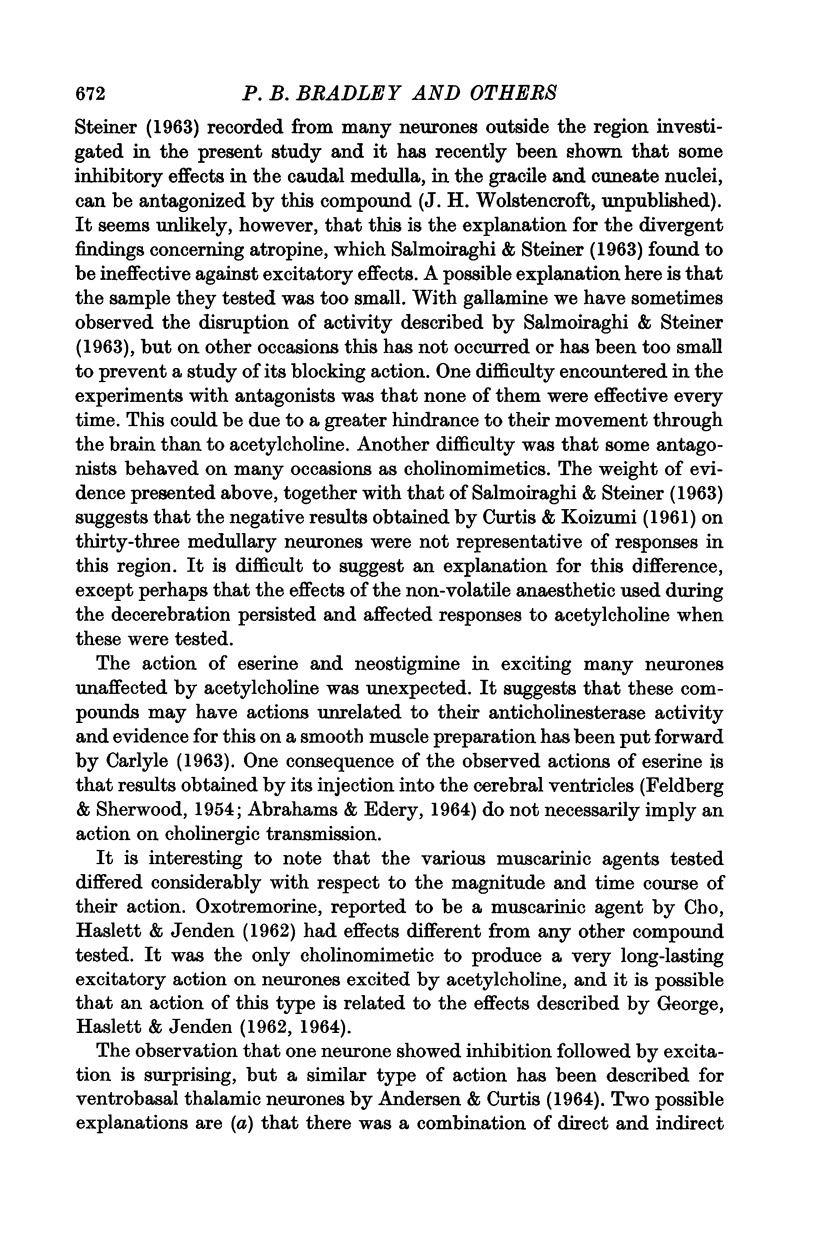
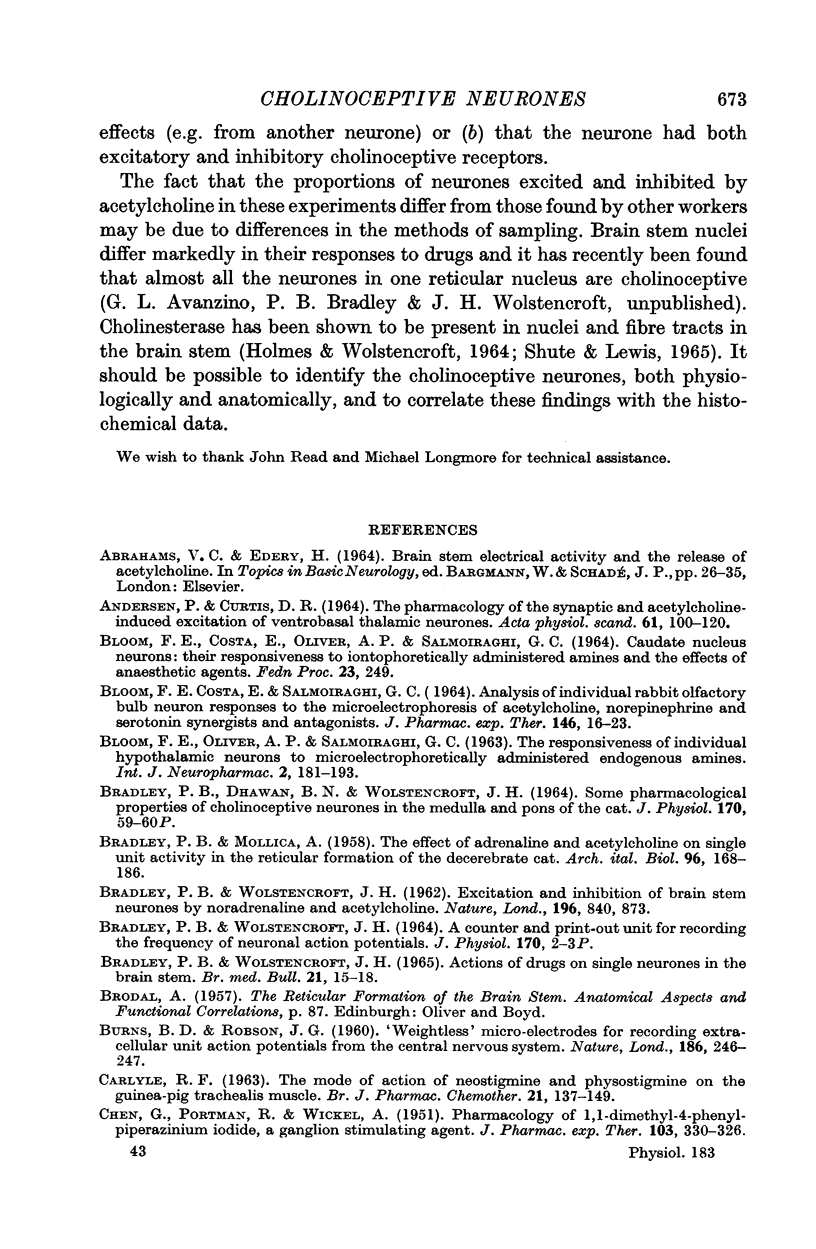
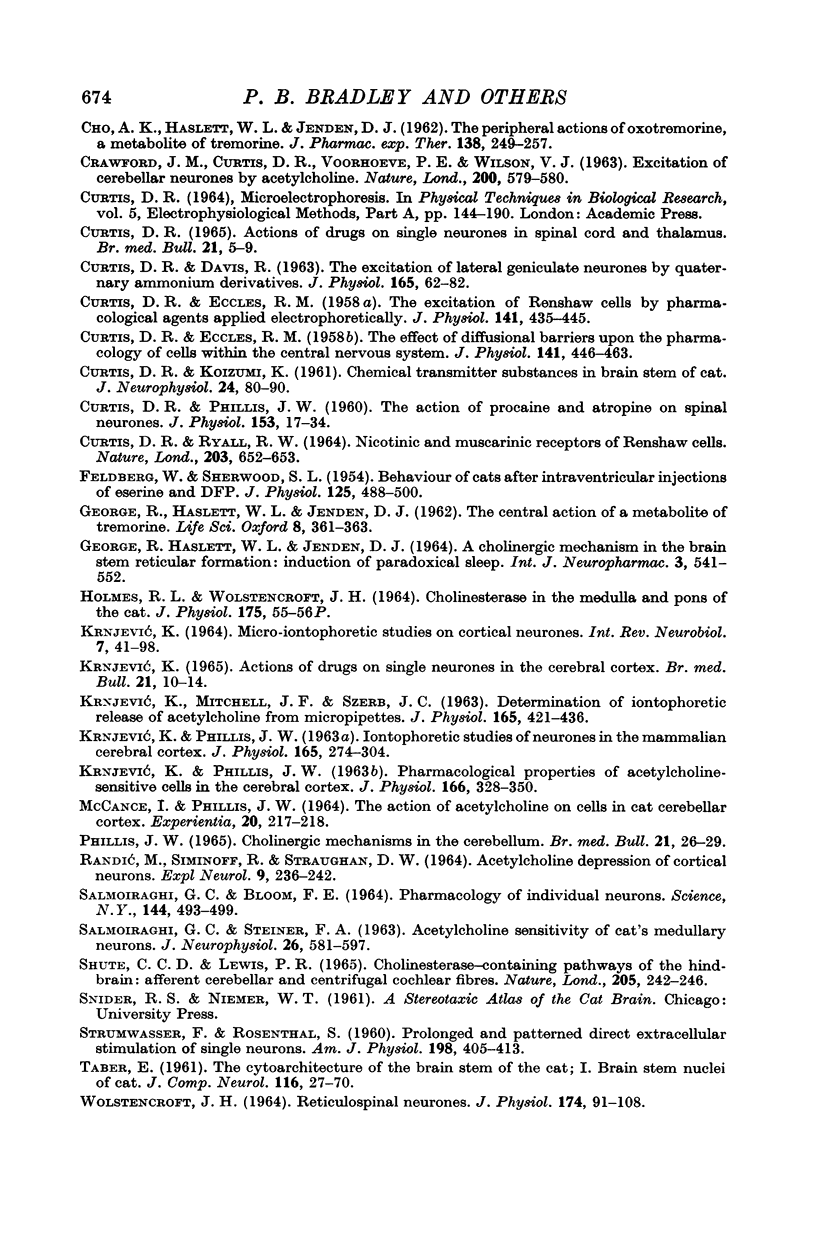
Selected References
These references are in PubMed. This may not be the complete list of references from this article.
- ANDERSEN P., CURTIS D. R. THE PHARMACOLOGY OF THE SYNAPTIC AND ACETYLCHOLINE-INDUCED EXCITATION OF VENTROBASAL THALAMIC NEURONES. Acta Physiol Scand. 1964 May-Jun;61:100–120. doi: 10.1111/j.1748-1716.1964.tb02946.x. [DOI] [PubMed] [Google Scholar]
- BLOOM F. E., COSTA E., SALMOIRAGHI G. C. ANALYSIS OF INDIVIDUAL RABBIT OLFACTORY BULB NEURON RESPONSES TO THE MICROELECTROPHORESIS OF ACETYLCHOLINE, NOREPINEPHRINE AND SEROTONIN SYNERGISTS AND ANTAGONISTS. J Pharmacol Exp Ther. 1964 Oct;146:16–23. [PubMed] [Google Scholar]
- BRADLEY P. B., WOLSTENCROFT J. H. ACTIONS OF DRUGS ON SINGLE NEURONES IN THE BRAIN-STEM. Br Med Bull. 1965 Jan;21:15–18. doi: 10.1093/oxfordjournals.bmb.a070349. [DOI] [PubMed] [Google Scholar]
- BRADLEY P. B., WOLSTENCROFT J. H. Excitaion and inhibition of brain-stem neurones by noradrenaline and acetylcholine. Nature. 1962 Dec 1;196:840–passim. doi: 10.1038/196840a0. [DOI] [PubMed] [Google Scholar]
- BURNS B. D., ROBSON J. G. 'Weightless' micro-electrodes for recording extracellular unit action potentials from the central nervous system. Nature. 1960 Apr 16;186:246–247. doi: 10.1038/186246a0. [DOI] [PubMed] [Google Scholar]
- CARLYLE R. F. THE MODE OF ACTION OF NEOSTIGMINE AND PHYSOSTIGMINE ON THE GUINEA-PIG TRACHEALIS MUSCLE. Br J Pharmacol Chemother. 1963 Aug;21:137–149. doi: 10.1111/j.1476-5381.1963.tb01509.x. [DOI] [PMC free article] [PubMed] [Google Scholar]
- CHEN G., PORTMAN R., WICKEL A. Pharmacology of 1,1-dimethyl-4-phenylpiperazinium iodide, a ganglion stimulating agent. J Pharmacol Exp Ther. 1951 Nov;103(3):330–336. [PubMed] [Google Scholar]
- CHO A. K., HASLETT W. L., JENDEN D. J. The peripheral actions of oxotremorine, a metabolite of tremorine. J Pharmacol Exp Ther. 1962 Nov;138:249–257. [PubMed] [Google Scholar]
- CRAWFORD J. M., CURTIS D. R., VOORHOEVE P. E., WILSON V. J. EXCITATION OF CEREBELLAR NEURONES BY ACETYLCHOLINE. Nature. 1963 Nov 9;200:579–580. doi: 10.1038/200579b0. [DOI] [PubMed] [Google Scholar]
- CURTIS D. R. ACTIONS OF DRUGS ON SINGLE NEURONES IN THE SPINAL CORD AND THALAMUS. Br Med Bull. 1965 Jan;21:5–9. doi: 10.1093/oxfordjournals.bmb.a070356. [DOI] [PubMed] [Google Scholar]
- CURTIS D. R., DAVIS R. The excitation of lateral geniculate neurones by quaternary ammonium derivatives. J Physiol. 1963 Jan;165:62–82. doi: 10.1113/jphysiol.1963.sp007042. [DOI] [PMC free article] [PubMed] [Google Scholar]
- CURTIS D. R., ECCLES R. M. The effect of diffusional barriers upon the pharmacology of cells within the central nervous system. J Physiol. 1958 May 28;141(3):446–463. doi: 10.1113/jphysiol.1958.sp005988. [DOI] [PMC free article] [PubMed] [Google Scholar]
- CURTIS D. R., ECCLES R. M. The excitation of Renshaw cells by pharmacological agents applied electrophoretically. J Physiol. 1958 May 28;141(3):435–445. doi: 10.1113/jphysiol.1958.sp005987. [DOI] [PMC free article] [PubMed] [Google Scholar]
- CURTIS D. R., KOIZUMI K. Chemical transmitter substances in brain stem of cat. J Neurophysiol. 1961 Jan;24:80–90. doi: 10.1152/jn.1961.24.1.80. [DOI] [PubMed] [Google Scholar]
- CURTIS D. R., PHILLIS J. W. The action of procaine and atropine on spinal neurones. J Physiol. 1960 Aug;153:17–34. doi: 10.1113/jphysiol.1960.sp006516. [DOI] [PMC free article] [PubMed] [Google Scholar]
- CURTIS D. R., RYALL R. W. NICOTINIC AND MUSCARINIC RECEPTORS OF RENSHAW CELLS. Nature. 1964 Aug 8;203:652–653. doi: 10.1038/203652a0. [DOI] [PubMed] [Google Scholar]
- FELDBERG W., SHERWOOD S. L. Behaviour of cats after intraventricular injections of eserine and DFP. J Physiol. 1954 Sep 28;125(3):488–500. doi: 10.1113/jphysiol.1954.sp005175. [DOI] [PMC free article] [PubMed] [Google Scholar]
- GEORGE R., HASLETT W. L., JENDEN D. J. A CHOLINERGIC MECHANISM IN THE BRAINSTEM RETICULAR FORMATION: INDUCTION OF PARADOXICAL SLEEP. Int J Neuropharmacol. 1964 Dec;3:541–552. doi: 10.1016/0028-3908(64)90076-0. [DOI] [PubMed] [Google Scholar]
- GEORGE R., HASLETT W. L., JENDEN D. J. The central action of a metabolite of tremorine. Life Sci. 1962 Aug;1:361–363. doi: 10.1016/0024-3205(62)90060-7. [DOI] [PubMed] [Google Scholar]
- KRNJEVIC K. ACTIONS OF DRUGS ON SINGLE NEURONES IN THE CEREBRAL CORTEX. Br Med Bull. 1965 Jan;21:10–14. doi: 10.1093/oxfordjournals.bmb.a070348. [DOI] [PubMed] [Google Scholar]
- KRNJEVIC K., MITCHELL J. F., SZERB J. C. Determination of iontophoretic release of acetylcholine from micropipettes. J Physiol. 1963 Mar;165:421–436. doi: 10.1113/jphysiol.1963.sp007067. [DOI] [PMC free article] [PubMed] [Google Scholar]
- KRNJEVIC K., PHILLIS J. W. Iontophoretic studies of neurones in the mammalian cerebral cortex. J Physiol. 1963 Feb;165:274–304. doi: 10.1113/jphysiol.1963.sp007057. [DOI] [PMC free article] [PubMed] [Google Scholar]
- Krnjević K., Phillis J. W. Pharmacological properties of acetylcholine-sensitive cells in the cerebral cortex. J Physiol. 1963 May;166(2):328–350. doi: 10.1113/jphysiol.1963.sp007107. [DOI] [PMC free article] [PubMed] [Google Scholar]
- McCance I., Phillis J. W. The action of acetylcholine on cells in cat cerebellar cortex. Experientia. 1964 Apr 15;20(4):217–218. doi: 10.1007/BF02135411. [DOI] [PubMed] [Google Scholar]
- PHILLIS J. W. CHOLINERGIC MECHANISMS IN THE CEREBELLUM. Br Med Bull. 1965 Jan;21:26–29. doi: 10.1093/oxfordjournals.bmb.a070351. [DOI] [PubMed] [Google Scholar]
- RANDIC M., SIMINOFF R., STRAUGHAN D. W. ACETYLCHOLINE DEPRESSION OF CORTICAL NEURONS. Exp Neurol. 1964 Mar;9:236–242. doi: 10.1016/0014-4886(64)90020-2. [DOI] [PubMed] [Google Scholar]
- SALMOIRAGHI G. C., BLOOM F. E. PHARMACOLOGY OF INDIVIDUAL NEURONS. Science. 1964 May 1;144(3618):493–499. doi: 10.1126/science.144.3618.493. [DOI] [PubMed] [Google Scholar]
- SALMOIRAGHI G. C., STEINER F. A. Acetylcholine sensitivity of cat's medullary neurons. J Neurophysiol. 1963 Jul;26:581–597. doi: 10.1152/jn.1963.26.4.581. [DOI] [PubMed] [Google Scholar]
- SHUTE C. C., LEWIS P. R. CHOLINESTERASE-CONTAINING PATHWAYS OF THE HINDBRAIN: AFFERENT CEREBELLAR AND CENTRIFUGAL COCHLEAR FIBRES. Nature. 1965 Jan 16;205:242–246. doi: 10.1038/205242a0. [DOI] [PubMed] [Google Scholar]
- STRUMWASSER F., ROSENTHAL S. Prolonged and patterned direct extracellular stimulation of single neurons. Am J Physiol. 1960 Feb;198:405–413. doi: 10.1152/ajplegacy.1960.198.2.405. [DOI] [PubMed] [Google Scholar]
- TABER E. The cytoarchitecture of the brain stem of the cat. I. Brain stem nuclei of cat. J Comp Neurol. 1961 Feb;116:27–69. doi: 10.1002/cne.901160104. [DOI] [PubMed] [Google Scholar]
- WOLSTENCROFT J. H. RETICULOSPINAL NEURONES. J Physiol. 1964 Oct;174:91–108. doi: 10.1113/jphysiol.1964.sp007475. [DOI] [PMC free article] [PubMed] [Google Scholar]


